Junliang Yu
When Graph Contrastive Learning Backfires: Spectral Vulnerability and Defense in Recommendation
Jul 10, 2025Abstract:Graph Contrastive Learning (GCL) has demonstrated substantial promise in enhancing the robustness and generalization of recommender systems, particularly by enabling models to leverage large-scale unlabeled data for improved representation learning. However, in this paper, we reveal an unexpected vulnerability: the integration of GCL inadvertently increases the susceptibility of a recommender to targeted promotion attacks. Through both theoretical investigation and empirical validation, we identify the root cause as the spectral smoothing effect induced by contrastive optimization, which disperses item embeddings across the representation space and unintentionally enhances the exposure of target items. Building on this insight, we introduce CLeaR, a bi-level optimization attack method that deliberately amplifies spectral smoothness, enabling a systematic investigation of the susceptibility of GCL-based recommendation models to targeted promotion attacks. Our findings highlight the urgent need for robust countermeasures; in response, we further propose SIM, a spectral irregularity mitigation framework designed to accurately detect and suppress targeted items without compromising model performance. Extensive experiments on multiple benchmark datasets demonstrate that, compared to existing targeted promotion attacks, GCL-based recommendation models exhibit greater susceptibility when evaluated with CLeaR, while SIM effectively mitigates these vulnerabilities.
Diversity-aware Dual-promotion Poisoning Attack on Sequential Recommendation
Apr 09, 2025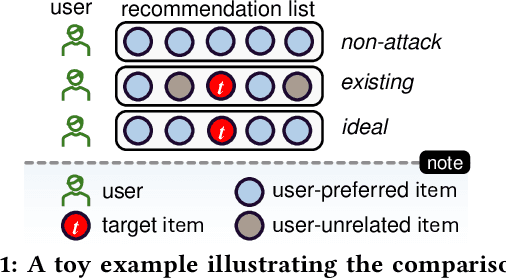

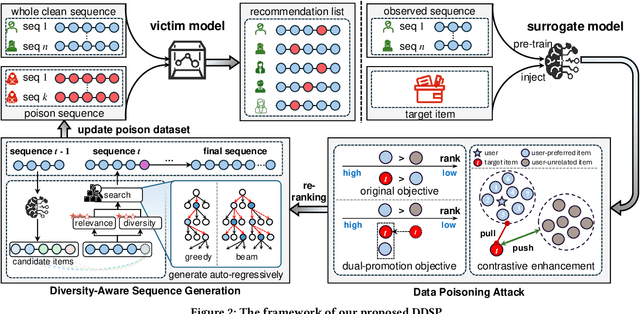
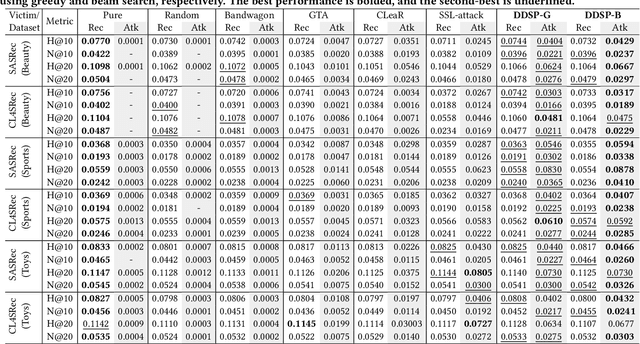
Abstract:Sequential recommender systems (SRSs) excel in capturing users' dynamic interests, thus playing a key role in various industrial applications. The popularity of SRSs has also driven emerging research on their security aspects, where data poisoning attack for targeted item promotion is a typical example. Existing attack mechanisms primarily focus on increasing the ranks of target items in the recommendation list by injecting carefully crafted interactions (i.e., poisoning sequences), which comes at the cost of demoting users' real preferences. Consequently, noticeable recommendation accuracy drops are observed, restricting the stealthiness of the attack. Additionally, the generated poisoning sequences are prone to substantial repetition of target items, which is a result of the unitary objective of boosting their overall exposure and lack of effective diversity regularizations. Such homogeneity not only compromises the authenticity of these sequences, but also limits the attack effectiveness, as it ignores the opportunity to establish sequential dependencies between the target and many more items in the SRS. To address the issues outlined, we propose a Diversity-aware Dual-promotion Sequential Poisoning attack method named DDSP for SRSs. Specifically, by theoretically revealing the conflict between recommendation and existing attack objectives, we design a revamped attack objective that promotes the target item while maintaining the relevance of preferred items in a user's ranking list. We further develop a diversity-aware, auto-regressive poisoning sequence generator, where a re-ranking method is in place to sequentially pick the optimal items by integrating diversity constraints.
RuleAgent: Discovering Rules for Recommendation Denoising with Autonomous Language Agents
Mar 30, 2025Abstract:The implicit feedback (e.g., clicks) in real-world recommender systems is often prone to severe noise caused by unintentional interactions, such as misclicks or curiosity-driven behavior. A common approach to denoising this feedback is manually crafting rules based on observations of training loss patterns. However, this approach is labor-intensive and the resulting rules often lack generalization across diverse scenarios. To overcome these limitations, we introduce RuleAgent, a language agent based framework which mimics real-world data experts to autonomously discover rules for recommendation denoising. Unlike the high-cost process of manual rule mining, RuleAgent offers rapid and dynamic rule discovery, ensuring adaptability to evolving data and varying scenarios. To achieve this, RuleAgent is equipped with tailored profile, memory, planning, and action modules and leverages reflection mechanisms to enhance its reasoning capabilities for rule discovery. Furthermore, to avoid the frequent retraining in rule discovery, we propose LossEraser-an unlearning strategy that streamlines training without compromising denoising performance. Experiments on benchmark datasets demonstrate that, compared with existing denoising methods, RuleAgent not only derives the optimal recommendation performance but also produces generalizable denoising rules, assisting researchers in efficient data cleaning.
A Survey on Point-of-Interest Recommendation: Models, Architectures, and Security
Oct 03, 2024



Abstract:The widespread adoption of smartphones and Location-Based Social Networks has led to a massive influx of spatio-temporal data, creating unparalleled opportunities for enhancing Point-of-Interest (POI) recommendation systems. These advanced POI systems are crucial for enriching user experiences, enabling personalized interactions, and optimizing decision-making processes in the digital landscape. However, existing surveys tend to focus on traditional approaches and few of them delve into cutting-edge developments, emerging architectures, as well as security considerations in POI recommendations. To address this gap, our survey stands out by offering a comprehensive, up-to-date review of POI recommendation systems, covering advancements in models, architectures, and security aspects. We systematically examine the transition from traditional models to advanced techniques such as large language models. Additionally, we explore the architectural evolution from centralized to decentralized and federated learning systems, highlighting the improvements in scalability and privacy. Furthermore, we address the increasing importance of security, examining potential vulnerabilities and privacy-preserving approaches. Our taxonomy provides a structured overview of the current state of POI recommendation, while we also identify promising directions for future research in this rapidly advancing field.
LLM-Powered Text Simulation Attack Against ID-Free Recommender Systems
Sep 19, 2024



Abstract:The ID-free recommendation paradigm has been proposed to address the limitation that traditional recommender systems struggle to model cold-start users or items with new IDs. Despite its effectiveness, this study uncovers that ID-free recommender systems are vulnerable to the proposed Text Simulation attack (TextSimu) which aims to promote specific target items. As a novel type of text poisoning attack, TextSimu exploits large language models (LLM) to alter the textual information of target items by simulating the characteristics of popular items. It operates effectively in both black-box and white-box settings, utilizing two key components: a unified popularity extraction module, which captures the essential characteristics of popular items, and an N-persona consistency simulation strategy, which creates multiple personas to collaboratively synthesize refined promotional textual descriptions for target items by simulating the popular items. To withstand TextSimu-like attacks, we further explore the detection approach for identifying LLM-generated promotional text. Extensive experiments conducted on three datasets demonstrate that TextSimu poses a more significant threat than existing poisoning attacks, while our defense method can detect malicious text of target items generated by TextSimu. By identifying the vulnerability, we aim to advance the development of more robust ID-free recommender systems.
Consistency and Discrepancy-Based Contrastive Tripartite Graph Learning for Recommendations
Jul 06, 2024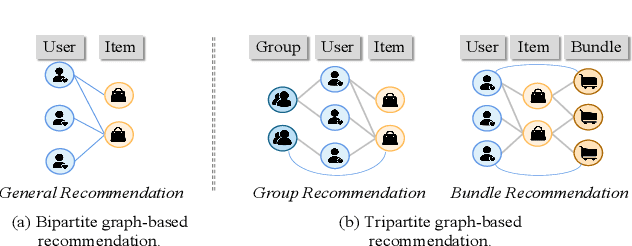
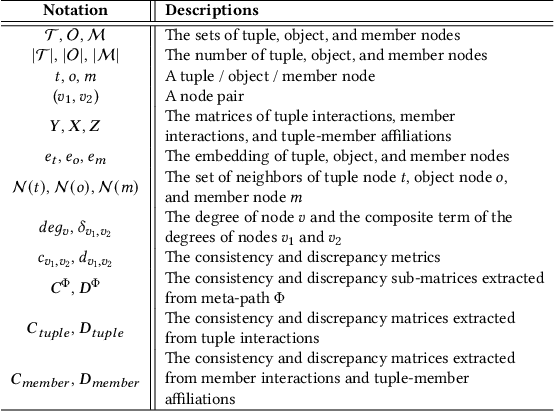
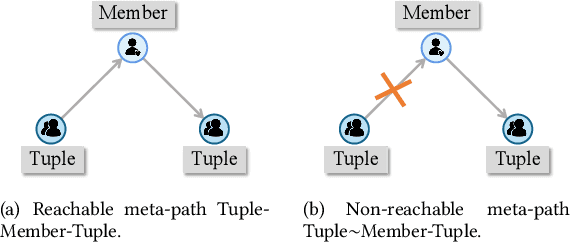

Abstract:Tripartite graph-based recommender systems markedly diverge from traditional models by recommending unique combinations such as user groups and item bundles. Despite their effectiveness, these systems exacerbate the longstanding cold-start problem in traditional recommender systems, because any number of user groups or item bundles can be formed among users or items. To address this issue, we introduce a Consistency and Discrepancy-based graph contrastive learning method for tripartite graph-based Recommendation. This approach leverages two novel meta-path-based metrics consistency and discrepancy to capture nuanced, implicit associations between the recommended objects and the recommendees. These metrics, indicative of high-order similarities, can be efficiently calculated with infinite graph convolutional networks layers under a multi-objective optimization framework, using the limit theory of GCN.
Poisoning Attacks and Defenses in Recommender Systems: A Survey
Jun 03, 2024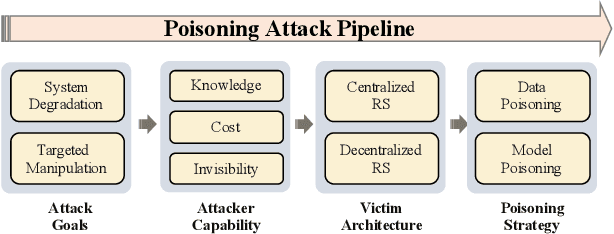



Abstract:Modern recommender systems (RS) have profoundly enhanced user experience across digital platforms, yet they face significant threats from poisoning attacks. These attacks, aimed at manipulating recommendation outputs for unethical gains, exploit vulnerabilities in RS through injecting malicious data or intervening model training. This survey presents a unique perspective by examining these threats through the lens of an attacker, offering fresh insights into their mechanics and impacts. Concretely, we detail a systematic pipeline that encompasses four stages of a poisoning attack: setting attack goals, assessing attacker capabilities, analyzing victim architecture, and implementing poisoning strategies. The pipeline not only aligns with various attack tactics but also serves as a comprehensive taxonomy to pinpoint focuses of distinct poisoning attacks. Correspondingly, we further classify defensive strategies into two main categories: poisoning data filtering and robust training from the defender's perspective. Finally, we highlight existing limitations and suggest innovative directions for further exploration in this field.
Rethinking and Accelerating Graph Condensation: A Training-Free Approach with Class Partition
May 22, 2024



Abstract:The increasing prevalence of large-scale graphs poses a significant challenge for graph neural network training, attributed to their substantial computational requirements. In response, graph condensation (GC) emerges as a promising data-centric solution aiming to substitute the large graph with a small yet informative condensed graph to facilitate data-efficient GNN training. However, existing GC methods suffer from intricate optimization processes, necessitating excessive computing resources. In this paper, we revisit existing GC optimization strategies and identify two pervasive issues: 1. various GC optimization strategies converge to class-level node feature matching between the original and condensed graphs, making the optimization target coarse-grained despite the complex computations; 2. to bridge the original and condensed graphs, existing GC methods rely on a Siamese graph network architecture that requires time-consuming bi-level optimization with iterative gradient computations. To overcome these issues, we propose a training-free GC framework termed Class-partitioned Graph Condensation (CGC), which refines the node feature matching from the class-to-class paradigm into a novel class-to-node paradigm. Remarkably, this refinement also simplifies the GC optimization as a class partition problem, which can be efficiently solved by any clustering methods. Moreover, CGC incorporates a pre-defined graph structure to enable a closed-form solution for condensed node features, eliminating the back-and-forth gradient descent in existing GC approaches without sacrificing accuracy. Extensive experiments demonstrate that CGC achieves state-of-the-art performance with a more efficient condensation process. For instance, compared with the seminal GC method (i.e., GCond), CGC condenses the largest Reddit graph within 10 seconds, achieving a 2,680X speedup and a 1.4% accuracy increase.
Prompt-enhanced Federated Content Representation Learning for Cross-domain Recommendation
Jan 31, 2024



Abstract:Cross-domain Recommendation (CDR) as one of the effective techniques in alleviating the data sparsity issues has been widely studied in recent years. However, previous works may cause domain privacy leakage since they necessitate the aggregation of diverse domain data into a centralized server during the training process. Though several studies have conducted privacy preserving CDR via Federated Learning (FL), they still have the following limitations: 1) They need to upload users' personal information to the central server, posing the risk of leaking user privacy. 2) Existing federated methods mainly rely on atomic item IDs to represent items, which prevents them from modeling items in a unified feature space, increasing the challenge of knowledge transfer among domains. 3) They are all based on the premise of knowing overlapped users between domains, which proves impractical in real-world applications. To address the above limitations, we focus on Privacy-preserving Cross-domain Recommendation (PCDR) and propose PFCR as our solution. For Limitation 1, we develop a FL schema by exclusively utilizing users' interactions with local clients and devising an encryption method for gradient encryption. For Limitation 2, we model items in a universal feature space by their description texts. For Limitation 3, we initially learn federated content representations, harnessing the generality of natural language to establish bridges between domains. Subsequently, we craft two prompt fine-tuning strategies to tailor the pre-trained model to the target domain. Extensive experiments on two real-world datasets demonstrate the superiority of our PFCR method compared to the SOTA approaches.
Graph Condensation: A Survey
Jan 22, 2024



Abstract:The burgeoning volume of graph data poses significant challenges in storage, transmission, and particularly the training of graph neural networks (GNNs). To address these challenges, graph condensation (GC) has emerged as an innovative solution. GC focuses on synthesizing a compact yet highly representative graph, on which GNNs can achieve performance comparable to trained on the large original graph. The notable efficacy of GC and its broad prospects have garnered significant attention and spurred extensive research. This survey paper provides an up-to-date and systematic overview of GC, organizing existing research into four categories aligned with critical GC evaluation criteria: effectiveness, generalization, fairness, and efficiency. To facilitate an in-depth and comprehensive understanding of GC, we examine various methods under each category and thoroughly discuss two essential components within GC: optimization strategies and condensed graph generation. Additionally, we introduce the applications of GC in a variety of fields, and highlight the present challenges and novel insights in GC, promoting advancements in future research.
 Add to Chrome
Add to Chrome Add to Firefox
Add to Firefox Add to Edge
Add to Edge